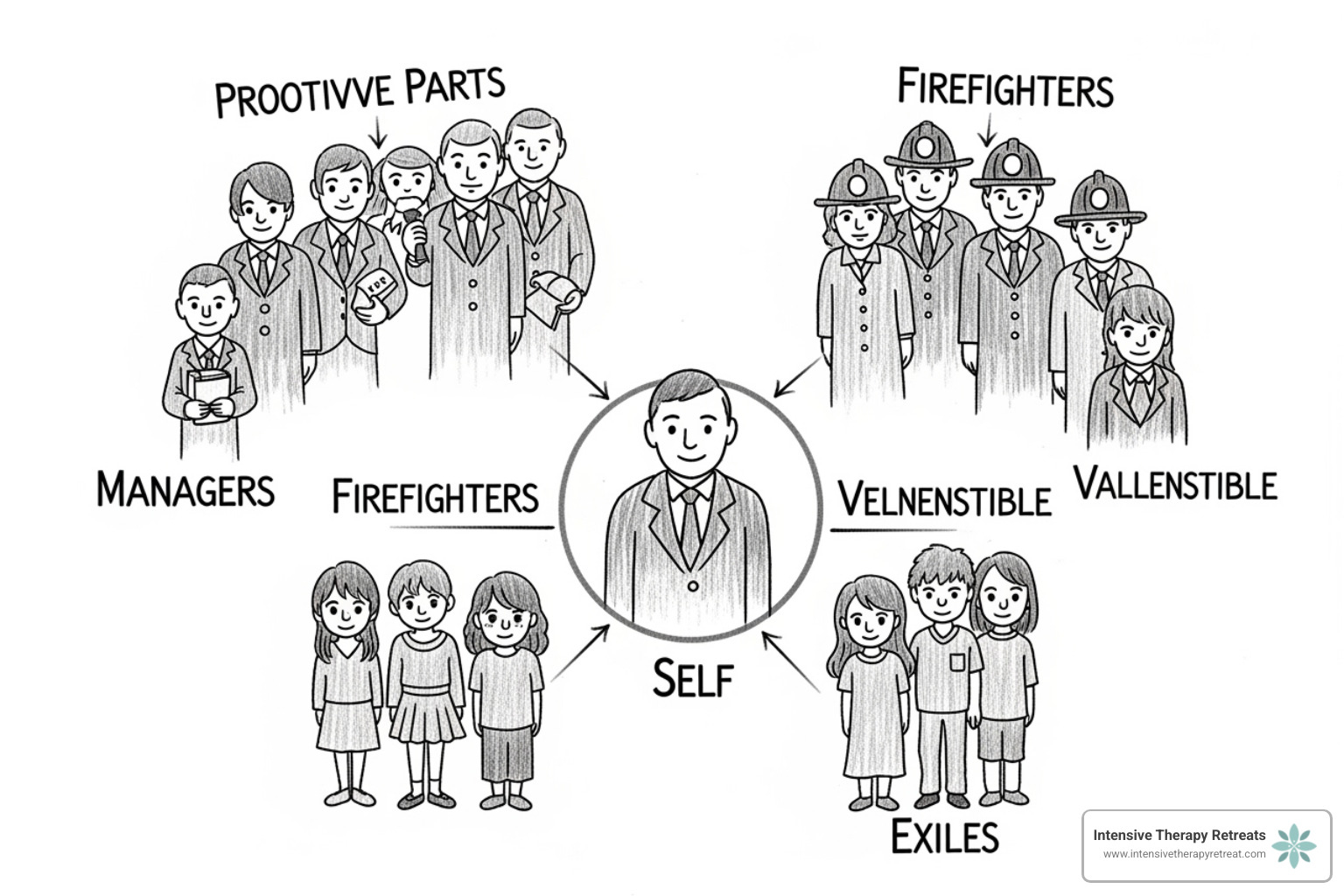Why Understanding the 6 Fs of IFS Can Transform Your Inner World
The 6 fs of ifs are the foundational steps in Internal Family Systems (IFS) therapy for connecting with and healing your inner parts. These six steps—Find, Focus, Flesh Out, Feel Toward, Befriend, and Fear—offer a structured path to build relationships with your internal system and promote deep healing.
The 6 Fs of IFS Process:
- Find – Identify the part that needs attention
- Focus – Turn your attention inward to that specific part
- Flesh Out – Explore the part’s story, role, and characteristics
- Feel Toward – Check your feelings toward the part from Self
- Befriend – Build a trusting, compassionate relationship with the part
- Fear – Understand what the protector part is afraid would happen
IFS uses memorable frameworks like the 6 F’s, 8 C’s, and 5 P’s. These alliterative guides are powerful roadmaps for navigating your complex inner world.
IFS therapy views the mind as an ecosystem of sub-personalities or “parts.” Each part has unique perspectives and emotions. While some are protective and others are wounded, all have good intentions, even when their actions feel overwhelming.
The 6 F’s process is designed for working with your protector parts—the aspects of you in extreme roles to keep you safe. Following these steps allows your core Self to connect compassionately with these protectors, eventually creating access to the vulnerable exile parts they guard.
As a clinical psychologist with decades of experience, I’ve found the 6 fs of ifs to be a highly effective framework for helping trauma survivors. I’ve witnessed profound healing as clients learn to lead their internal systems with curiosity and compassion instead of judgment.
Understanding the Foundations: What is Internal Family Systems (IFS) Therapy?
Internal Family Systems (IFS) therapy, developed by Dr. Richard Schwartz, views the mind as a collection of sub-personalities or “parts.” Unlike approaches that label conflicting behaviors as symptoms, IFS recognizes that these parts developed to help us steer life.
The core insight is that every part, no matter how challenging, has positive intentions. A critical part may be trying to prevent failure, while a withdrawn part may be protecting you from hurt. Instead of fighting these parts, IFS invites you to build a relationship with them. The 6 fs of ifs process is the roadmap for this internal dialogue.
At the center of this system is the core Self—a wise, compassionate, and undamaged inner resource with the innate capacity to heal and lead.
You can explore more about this transformative approach in our comprehensive guide on Internal Family Systems Therapy Explained.
The Core Self and Its Qualities
Your core Self is the center of your inner system, an undamaged state of being. When you access your Self, you embody powerful and peaceful qualities. IFS describes these as the 8 C’s (Curiosity, Calm, Confidence, Compassion, Creativity, Clarity, Courage, Connectedness) and the 5 P’s (Playfulness, Patience, Persistence, Perspective, Presence).
These qualities are innate; you don’t need to create them. They emerge when your parts feel safe enough to let Self lead. The 6 fs of ifs process helps create this safety, allowing your Self-energy to shine. When parts trust that Self can handle challenges, they relax their extreme roles, and lasting healing begins.
Your Internal Family: The Three Types of Parts
Your internal system has three types of parts that can explain inner conflicts.
Managers are proactive protectors. They manage your daily life to keep you safe and functional, often through planning, perfectionism, or people-pleasing to avoid pain.
Firefighters are reactive protectors. They emerge when emotional pain breaks through, using urgent methods to douse the feelings. This can include numbing behaviors, angry outbursts, or distractions.
Exiles are the young, wounded parts holding burdens from past trauma, neglect, or overwhelming experiences. They carry intense emotions like shame, fear, and sadness, which managers and firefighters work to keep contained.
The entire system, including the protectors, developed to help you survive. The 6 fs of ifs provide a gentle path to build trust with your protectors so you can safely access and heal the exiles they guard.
The Core Process: A Deep Dive into the 6 Fs of IFS
The 6 fs of ifs are a step-by-step guide for navigating your inner world. This process transforms overwhelming emotions or thoughts into conversations with distinct parts of yourself. Each step builds on the last, creating a safe, gentle pathway from noticing a part to understanding its deepest concerns. The goal is to foster authentic dialogue within your internal system.
Find: Locating the Part That Needs Attention
The first step is finding the part that needs attention. This part often makes itself known through physical sensations (a knot in your stomach), emotions (a surge of irritation), or persistent thoughts. Pay attention to your body, as it often signals which part is active. Ask yourself: “Is there a part of me that’s feeling this?” This question creates separation. You are not the feeling; you have a part that feels that way. This shift moves you from being overwhelmed by an emotion to being in a relationship with the part experiencing it.
Focus: Turning Your Attention Inward
After finding a part, focusing means giving it your full, curious attention. Turn inward and ask, “Where do I sense this part in my body?” or “What does it feel like?” The goal is not to fix it, but simply to acknowledge its presence. You can create internal space by closing your eyes and breathing slowly. This focused attention helps the part feel seen and allows it to reveal more about itself, such as images or memories. By showing up, you begin to build trust.
Flesh Out: Getting to Know Your Part’s Story
Next, flesh out the part’s story. Get curious about its identity and purpose. Ask questions like: “What does this part look like?” (It could be an image, a color, or a sensation). “What role has this part been playing in my life?” A perfectionist part might reveal its job is to help you avoid criticism. “When did you start doing this job?” This question can uncover the part’s history and origins. This step transforms an abstract feeling into a relationship with a specific part, helping you understand its hard work and history.
Feel Toward: Assessing Your Relationship with the Part
After getting to know the part, pause and ask: “How do I feel toward this part right now?” This checks if you are connected to your core Self. If you feel curiosity, compassion, or calm, your Self is present. If you feel judgment, annoyance, or frustration, it’s a sign that another protective part has stepped in. This is valuable information, not a mistake. Simply turn your attention to this new part. Ask it to step back so you can connect with the original part from a place of Self-energy. This ensures the conversation is led by Self, not another part.
Befriend: Building a Trusting Inner Relationship
Befriending is about building an alliance with the part by appreciating its efforts. Acknowledge its positive intentions, even if its methods are challenging. You might say internally, “Thank you for working so hard to protect me.” Recognizing that a perfectionist part wants you to succeed or an anxious part wants you to be prepared helps it feel seen and valued. This builds the trust needed for change. When parts feel appreciated, they are more willing to relax their roles, knowing you are there to lead.
Fear: Understanding the Protector’s Core Concerns
The final step is to understand the part’s fear. Ask the protector: “What are you afraid would happen if you stopped doing your job?” The answer often reveals the vulnerable exile the part is shielding. For example, a perfectionist part might fear abandonment if you are seen as flawed. A controlling part might fear helplessness if it lets go. These fears point to the original wounds of exiled parts. Understanding this allows you to reassure the protector that you can now handle the pain, which helps it trust you and relax its extreme role.
You can deepen your practice with helpful resources like The Six Fs Internal Family Systems worksheet, which provides a structured guide through each step of this transformative process.
Practical Application: Using the 6 Fs of IFS for Healing
The 6 fs of ifs become a powerful tool when applied to daily life. They are a toolkit for emotional regulation and self-understanding. When you feel stuck or overwhelmed, these steps offer a gentle pathway to turn toward difficult emotions with curiosity instead of fighting them.
Can I Apply the 6 Fs of IFS on My Own?
Yes, many people find self-help benefits from practicing the 6 fs of ifs on their own, leading to greater self-awareness and compassion. However, common challenges can arise. A primary one is getting blended with parts—thinking you’re in Self when another part, like an inner critic, has taken over. This can lead to frustration. Some protective parts may also be too activated to trust you without help.
For deeper trauma work, professional guidance is essential. A skilled IFS therapist provides the safety and expertise to steer complex protective systems and work with highly wounded parts.
How IFS and the 6 Fs of IFS Address Trauma
The 6 fs of ifs are uniquely suited to address the dynamics of trauma. Trauma creates wounded, hidden parts (exiles) and other parts that adopt extreme protective roles to shield them.
The genius of IFS is working with protectors first. By using the 6 Fs to build trust with these guardians, you gain permission to access the pain they protect. This leads to unburdening trauma, where exiles release their long-held burdens of pain and shame.
The result is lasting emotional healing, not just symptom management, freeing up energy for joy and connection.
You can explore more about this transformative process in our guide on Internal Family Systems Therapy Treatment Process for Trauma.
The Unique Focus of IFS
IFS is unique for its internal system focus. It helps you understand the relationships inside your own mind. By harmonizing the inner world, your external relationships naturally improve. When your inner critic softens, you become less defensive. When your protectors feel safe, you can be more authentic with others.
This inside-out approach makes improving interpersonal relationships a natural result of inner healing. The 6 fs of ifs provide the roadmap to this internal harmony, helping you become the leader your inner system needs.
Frequently Asked Questions about the 6 Fs of IFS
We often encounter thoughtful questions about the 6 fs of ifs and how this framework works in practice. Here are some of the most common concerns.
What is the main goal of the 6 F’s process?
The main goal is to build a trusting relationship with your protective parts (managers and firefighters). By approaching them with Self-leadership, you help them feel seen and understood. The aim isn’t to eliminate them, but to earn their trust. When protectors trust that your Self can handle challenges, they relax their extreme roles and grant you access to the vulnerable exiles they guard. This restores harmony to your internal system, allowing it to function as a team led by your compassionate Self.
What happens if I feel judgmental or annoyed toward a part?
This is a common and useful experience in IFS. Feeling judgmental or annoyed means another protective part has stepped in and blended with you. It’s not a failure; it’s new information. The process is to simply shift your focus. Apply the 6 fs of ifs to this new judgmental part to understand its concerns and fears. Once this part feels heard, it will often relax, allowing you to return to the original part with genuine Self-energy, like curiosity and compassion.
What are the main benefits of practicing IFS therapy?
Practicing IFS, especially with the 6 fs of ifs, offers profound benefits that we see unfold rapidly in our intensive retreats. Key benefits include:
- Greater self-awareness: Understanding your inner landscape and the motivations of your parts.
- Improved emotional regulation: Learning to work with your emotions with curiosity instead of being overwhelmed by them.
- Increased self-compassion: Replacing inner criticism with kindness as you recognize the positive intentions of all your parts.
- Profound healing from past trauma: Unburdening the pain from exiled parts for lasting relief that goes beyond symptom management.
- Improved self-leadership: Operating from your core Self, leading to better relationships, clearer decisions, and a more authentic life.
Conclusion: Embracing Your Inner System for Lasting Wholeness
Internal Family Systems therapy reveals a profound truth: you are not broken. You have a wise, compassionate Self and parts that have tried to protect you.
The 6 fs of ifs are a structured pathway home to yourself. By learning to Find, Focus, Flesh Out, Feel Toward, Befriend, and understand the Fears of your parts, you fundamentally change your relationship with yourself. This inner reconciliation leads to greater emotional regulation, self-compassion, and authentic connections. The energy once used for internal conflict is freed for joy and creativity.
IFS recognizes that healing happens from within. You learn to access your own core Self to provide inner guidance, which allows you to show up more authentically in your relationships. This is a sustainable skill; you become your own inner healer, equipped with resilience and self-trust.
If you’re ready for profound change, our Intensive Therapy Retreats provide an immersive, safe environment to dive deep into IFS work. We help you achieve in days what might take months or years in traditional therapy.
Your inner system is waiting for your compassionate attention. Every part of you deserves to be heard, understood, and welcomed home by your Self.




